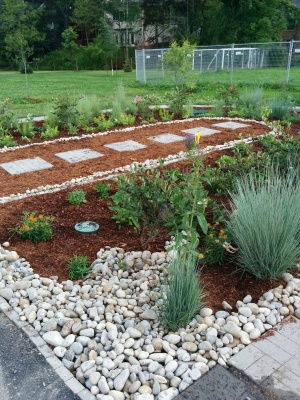Difference between revisions of "Stone"
Jump to navigation
Jump to search
Kyle menken (talk | contribs) m |
Kyle menken (talk | contribs) m |
||
| Line 2: | Line 2: | ||
[[File: IMAX_Stone_Inlet.jpeg|thumb|This bioswale in a parking lot uses stone at the inlets and along the bottom of the swale to prevent erosion, as the sides are sloped.]] | [[File: IMAX_Stone_Inlet.jpeg|thumb|This bioswale in a parking lot uses stone at the inlets and along the bottom of the swale to prevent erosion, as the sides are sloped.]] | ||
| − | For advice on aggregates used in [[Underdrains|underdrains]], see [[Gravel|gravel]] | + | Stone or gravel can serve as a low maintenance decorative feature, but it may also serve many practical functions in an LID practice. For advice on aggregates used in [[Underdrains|underdrains]], see [[Gravel|gravel]] |
| − | Stone can | + | {|class="wikitable" |
| − | + | |+ Stone functions and specifications | |
| − | + | !style="background: darkcyan; color: white"|Function | |
| − | Dissipate flow and prevent erosion at inlets and outlets | + | !style="background: darkcyan; color: white"|Recommended Specification |
| + | |- | ||
| + | |Subsurface storage layer for stormwater and to surround the underdrain or subdrain | ||
| + | | | ||
| + | *50mm diameter clear stone, washed and free of all fines, should be used | ||
| + | *The depth of the gravel subsurface storage layer is a minimum of 300 mm and the underdrain is set at least 100 mm above the bottom to provide a minimum infiltration volume | ||
| + | *A 100 mm pea gravel choking layer and optional drainage geotextile can be used to prevent the bioretention soil from migrating into the gravel storage layer and underdrain | ||
| + | *Geotextile is not recommended around the sides and bottom of the gravel storage layer as it has been found to be unnecessary and a common cause of early clogging | ||
| + | |- | ||
| + | |Dissipate flow and prevent erosion at inlets and outlets | ||
| + | | | ||
*Angular crushed stone, which will "knit" or lock together and be less likely to shift, is recommended. However, for aesthetic purposes, smooth river-run stone may be desired. | *Angular crushed stone, which will "knit" or lock together and be less likely to shift, is recommended. However, for aesthetic purposes, smooth river-run stone may be desired. | ||
*Determine stone size by flow velocities at inlets and outlets. Typical stone for this purpose ranges between 50 mm and 250 mm. The larger the stone, the more energy dissipation. | *Determine stone size by flow velocities at inlets and outlets. Typical stone for this purpose ranges between 50 mm and 250 mm. The larger the stone, the more energy dissipation. | ||
*Stone beds should be twice as thick as the largest stone's diameter. | *Stone beds should be twice as thick as the largest stone's diameter. | ||
*To prevent erosion of soils beneath the stone and the migration of the stone into the soil, the stone bed should be underlain by a drainage [[Geotextiles|geotextile]]. | *To prevent erosion of soils beneath the stone and the migration of the stone into the soil, the stone bed should be underlain by a drainage [[Geotextiles|geotextile]]. | ||
| − | + | |- | |
| − | Direct and spread flow throughout a large LID facility or to protect narrow channel sections where flow will concentrate | + | |Direct and spread flow throughout a large LID facility or to protect narrow channel sections where flow will concentrate |
| + | | | ||
*While crushed stone will be less likely to shift, river-run stone may be used to create a dry-stream-bed look. | *While crushed stone will be less likely to shift, river-run stone may be used to create a dry-stream-bed look. | ||
*The sizing of the gravel will depend on the expected velocities. | *The sizing of the gravel will depend on the expected velocities. | ||
| + | |} | ||
| + | |||
[[Category:Materials]] | [[Category:Materials]] | ||
[[Category:Landscaping]] | [[Category:Landscaping]] | ||
Revision as of 13:46, 10 January 2018
Stone or gravel can serve as a low maintenance decorative feature, but it may also serve many practical functions in an LID practice. For advice on aggregates used in underdrains, see gravel
| Function | Recommended Specification |
|---|---|
| Subsurface storage layer for stormwater and to surround the underdrain or subdrain |
|
| Dissipate flow and prevent erosion at inlets and outlets |
|
| Direct and spread flow throughout a large LID facility or to protect narrow channel sections where flow will concentrate |
|

